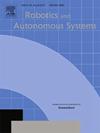模拟柔性双手在轨操作的空地试验台:从空中到空间机器人操作
IF 4.3
2区 计算机科学
Q1 AUTOMATION & CONTROL SYSTEMS
引用次数: 0
摘要
以非合作自由漂浮卫星的捕获与维护为典型用例,提出了一种基于空中机器人平台的模拟在轨双手操作的空中-地面机器人试验台的设计与开发。拟议的试验台设计旨在促进涉及物理交互的模拟的实现,利用来自空中机器人操作的技术,作为现有地面试验台设施的补充或替代解决方案。该系统由模拟目标卫星自由飞行/自由漂浮动力学的全驱动多旋翼(FAMR)和执行操纵任务的轻量级拟人化双臂系统(LiCAS)组成,在Simscape Multibody中实现动力学仿真。LiCAS的人体大小和类似人类的运动学允许复制人类操作员的操作技能,而其非常低的重量(2.5公斤)使得它可以安装在用于复制航天器运动的轻型工业机械臂上。考虑两种类型的兼容交互。一方面,仿真层实现接触后阶段的阻抗控制,使用右臂握住目标并与基座保持相对位姿,左臂执行操作任务。另一方面,在物理测试系统中,依靠LiCAS双臂的机械关节顺应性来评估碰撞检测和被动调节。在多转子上应用动量守恒原理,对自由浮动的FAMR与柔性臂之间的碰撞反射进行实验评估。该方法利用了空间和空中机器人操作在动力学建模方面的相似性,并在室内试验台进行了仿真和实验结果验证了所开发的框架。本文章由计算机程序翻译,如有差异,请以英文原文为准。

Aerial-ground testbed for simulating compliant bimanual on-orbit operations: From aerial to space robotic manipulation
This paper presents the design and development of an aerial-ground robotics testbed for simulating bimanual manipulation operations on orbit relying on aerial robotics platforms, considering as representative use case the capture and maintenance of a non-cooperative free-floating satellite. The proposed testbed design is intended to facilitate the realization of simulations involving physical interaction, taking benefit of the technologies derived from aerial robotic manipulation, to be used as a complementary or alternative solution to existing ground testbed facilities. The system consists of a fully actuated multi-rotor (FAMR) that emulates the free flying/free floating dynamics of a target satellite, and a lightweight and compliant anthropomorphic dual arm system (LiCAS) to conduct the manipulation task, implementing the dynamics simulation in Simscape Multibody. The human-size and human-like kinematics of the LiCAS allow to replicate the manipulation skills of human operators, whereas its very low weight (2.5 kg) makes it possible to mount it on lightweight industrial robotic arms used to reproduce the spacecraft motion. Two types of compliant interactions are considered. On the one hand, impedance control for the post-contact phase is implemented in the simulation layer, using the right arm to hold the target and maintain the relative pose with the base while the left arm conducts the manipulation task. On the other hand, collision detection and passive accommodation is evaluated in the physical testing system relying on the mechanical joint compliance of the LiCAS dual arm. Collision reflexes between the free-floating FAMR and the compliant arm will be also experimentally evaluated by applying the principle of momentum conservation on the multi-rotor. The proposed approach takes benefit of the similarities between space and aerial robotic manipulation in terms of dynamic modeling, presenting simulation and experimental results in an indoor testbed to validate the developed framework.
求助全文
通过发布文献求助,成功后即可免费获取论文全文。
去求助
来源期刊

Robotics and Autonomous Systems
工程技术-机器人学
CiteScore
9.00
自引率
7.00%
发文量
164
审稿时长
4.5 months
期刊介绍:
Robotics and Autonomous Systems will carry articles describing fundamental developments in the field of robotics, with special emphasis on autonomous systems. An important goal of this journal is to extend the state of the art in both symbolic and sensory based robot control and learning in the context of autonomous systems.
Robotics and Autonomous Systems will carry articles on the theoretical, computational and experimental aspects of autonomous systems, or modules of such systems.
 求助内容:
求助内容: 应助结果提醒方式:
应助结果提醒方式:


